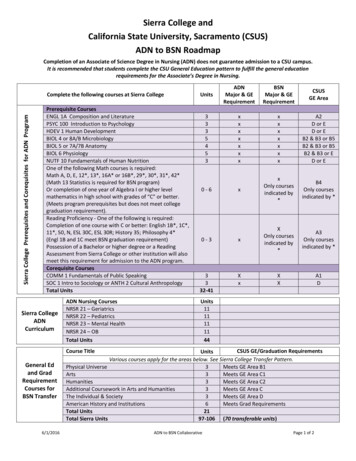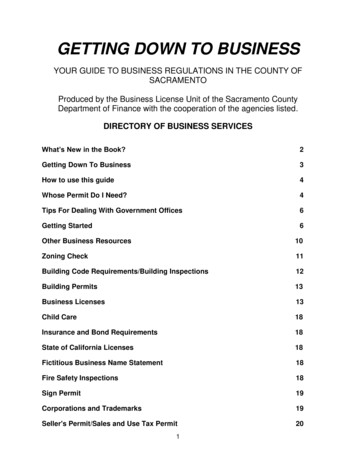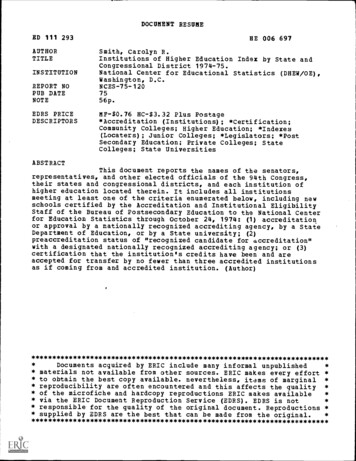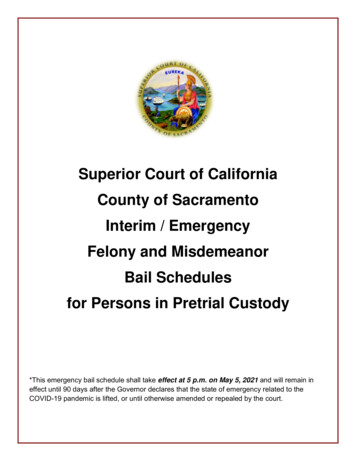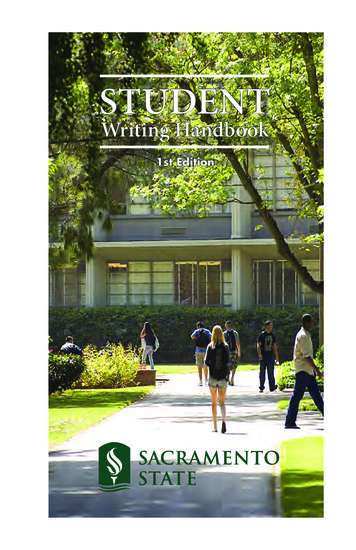
Transcription
STUDENTWriting Handbook1st Edition
Editorial Team – The Faculty Senate Writing andReading SubcommitteeDan Melzer, University Reading and Writing CoordinatorSheri Hembree, Child DevelopmentVirginia Kidd, Communication StudiesFiona Glade, English Department and Graduation Writing Assessment CoordinatorGreg Wheeler, Associate Dean of Undergraduate StudiesElaine McCollom, Learning SkillsJude Antonyappan, Social WorkContributors:Nancy Alkema, studentMerrikay Boylan, Family and Consumer SciencesBrad Baker, ChemistryLaura Basini, MusicEllen Berg, SociologyRobby Ching, Learning Skills CoordinatorDana Ferris, EnglishPeter Detwiler, Public Policy and AdministrationFiona Glade, English Department and Graduation Writing Assessment CoordinatorLinda Goff, LibraryLisa Hammersley, GeologyAmy Heckathorn, Writing Programs CoordinatorSheri Hembree, Child DevelopmentVirginia Kidd, Communication StudiesCynthia Linville, EnglishRani Marcos, studentTodd Migliaccio, SociologyRonald Moore, studentWendy Nelson, AnthropologyElaine O’Brien, ArtMary Reddick, LibraryCherryl Smith, EnglishMark Stoner, Communication StudiesRoger Sullivan, AnthropologyNathan Trueblood, BiologyKristin Van Gaasbeck, EconomicsJim Wanket, Geography Copyright 2009, Dan Melzer and the Sacramento State University Writing and ReadingSubcommittee
Table of ContentsPart I: About the Campus Writing Programs at Sacramento StateCampus Writing Programs Flow Chart. 2University Writing Rubric. 3Preparatory Writing Courses. 6College Composition Courses. 7Graduation Writing Assessment Requirement (GWAR). 9Writing Intensive Courses. 11The Learning Skills Center. 12The University Writing Center. 14The Library. 15Part II: University Writing, Reading, and Researching ProcessesAn Overview of University WritingWhat is “Academic” Writing?. 18Multilingual Students and College Writing. 23The Rhetorical Situation. 28Responses to Rhetorical Situations: Genres. 31Writing Critical Analyses and Academic Arguments. 34Advice for College Writing Processes. 36Understanding College Writing Assignments. 37Strategies for Finding Topics. 39Drafting and Revising. 42Editing and Proofreading Techniques. 45Strategies for Timed Writing. 47Peer Response. 49Writing in Groups. 52Writing Portfolios. 56Visual Rhetoric (Graphs, Charts, Web Sites, and More). 58
Advice for College Reading ProcessesCollege Reading is Critical Reading. 67Reading Difficult College Texts. 70College Reading Purposes. 77Advice for College Researching ProcessesCollege Research as Inquiry. 79Finding a Research Question. 81Locating Sources (Books, Databases, Surveys, Interviews,and More). 84Evaluating Sources. 94Integrating Sources. 96Understanding and Avoiding Plagiarism. 103Part III: Writing across the Curriculum at Sacramento StateWriting and Researching in the Natural Sciencesand Mathematics. 106Writing and Researching in the Social Sciences. 118Writing and Researching in the Arts and Humanities. 137Writing and Researching in Business and ProfessionalCommunications. 152Documentation StylesCSE. 169APA. 173MLA. 176Other Citation Styles. 180
PrefaceYour Writing Career at Sacramento State UniversityAs you progress in your career at Sacramento State, you’re going to growsignificantly as a writer and a thinker. In every department, your instructorsare going to use writing as a tool for learning and critical thinking. You’ll readchallenging and interesting texts and write about your responses to what you’rereading. You’ll conduct research to find out what others have said and thoughtabout the issue and ideas you’re exploring in your classes, and you’ll do some ofyour own original research as well to join in the conversation. You’ll use writingto evaluate the research you’ve read and communicate the original researchyou’ve done. Remember that writing at the university is about much more than justgrammar and mechanics. The most important purposes of writing in college areto communicate your ideas to readers, think critically about the content of yourclasses, and develop the ability to write to a variety of audiences for a variety ofpurposes.Sacramento State offers you a sequence of classes that will give you writingintensive experiences at each stage in your university career. At the first-year level,there are a variety of composition courses available that will introduce you tocollege-level writing and writing as a process, with opportunities to revise andget feedback from your peers and your teacher. At the sophomore level, English20 will help you make the transition from General Education to writing, reading,and researching in your major. At the junior level, you’ll take a course designatedWriting Intensive. This course will have a small class size, frequent writing, andplenty of opportunities to get feedback on your writing. If you need a little morepractice with college writing before you take the Writing Intensive course, youcan elect to take English 109W, a junior-level writing course, rather than takingthe WPJ (Writing Placement Junior Level). Academic departments at SacramentoState use writing assignments to help students learn the content of the major andthe kinds of writing that professionals in the major do, and many majors have acapstone course that asks you to write a substantial culminating essay or report.No matter what you major in, when you graduate from Sacramento State you canexpect to do a lot of writing on the job, so remember that the writing you do atSacramento State will help prepare you for life after college.We have high expectations for your writing and quality of thinking at SacramentoState, but we also provide a lot of support to help you grow as a writer. TheLearning Skills Center offers writing classes and tutoring for students who needsome extra help. The University Writing Center, located in 128 Calaveras Hall,offers free one-on-one help for writing for students in any course. Don’t forget thatyour instructors are also a great resource for help with your writing. Don’t be shyabout dropping by their office hours or making appointments with them to gethelp with your writing for their classes. We hope that this handbook will also be ahelpful resource to you throughout your writing career at Sacramento State.Faculty Senate Writing and Reading Subcommittee
About the Campus Writing Programs atSacramento State UniversityIn this first section of the student writing handbook, you’ll get an overview ofthe programs and resources on campus that are designed to help you with thereading, writing, and researching you’ll do in college. These resources include the Learning Skills Center English Composition courses like ENGL1, ENGL1A, and ENGL20 the University Writing Center Writing Intensive courses the Graduation Writing Assessment Requirement the LibraryTo help you get a sense of how Sacramento State has sequenced writing courses,the next page includes a flow chart of the entire program.1
Sacramento State University ComprehensiveCampus Writing Programs Flow ChartEnglish Placement test (if not exempt)Score of 148 146-147142-145141 or lessEnglish 1A orEnglish 2English 1A 1xEnglish 2 2xEnglish 1or LS87LS15 or LS86English 1AEnglish 2English 20 or English 20M or EquivalentUpper Division PlacementStudents may choose either:English 109W of 109M3-unit course which ends withportfolio placement in one of thefollowing:WPJ(Writing Placement for Juniors)Placement exam which gives oneof the following placements:3 units: Upper Division WritingIntensive Course4 units: Upper Division Writing IntensiveCourse 109x6 units: English 109W/M thenUpper-Division Writing Intensive Course10 units: LS86 (4U) the English 109M, thenUpper-Division Writing Intensive Course2
Sacramento State University Writing RubricThe following rubric was created by the Faculty Senate Subcommittee for Writing andReading. It is meant as a useful guide but not an absolute standard for the university:writing criteria will vary from instructor to instructor and discipline to discipline.An “A” paper: A paper in this category A ddresses the assignment thoughtfully and analytically, setting achallenging task Does not demonstrate a need for more revision. Displays awareness of and purpose in communicating to an audience. Establishes a clearly focused controlling idea. D emonstrates coherent and rhetorically sophisticated organization;makes effective connections between ideas. P rovides clear generalizations with specific detail and compellingsupport and analysis. C ites relevant sources and evaluates their validity, effectively integratingthem into the text when appropriate. D isplays evidence of careful editing with superior control of grammarand mechanics appropriate to the assignment.Guideline for multilingual writers: Grammatical errors are rare anddo not interfere with overall effectiveness of paper; occasionalimprecision in word choice and usage may occur.A “B” paper: A paper in this category Addresses the assignment clearly and analytically, setting a meaningful task. Does not demonstrate a need for significantly more revision. Addresses audience needs and expectations. Establishes a clearly focused controlling idea. Demonstrates clear and coherent organization. Provides clear generalizations and effective support and analysis. C ites relevant sources, effectively integrating them into the text whenappropriate. D isplays evidence of careful editing with consistent control of grammarand mechanics appropriate to the assignment and the discipline.3
Guideline for multilingual writers: Some grammatical errors mayoccur throughout the paper but do not interfere with overalleffectiveness; occasional inappropriate word choice or incorrectusage may occur.A “C” paper: A paper in this categoryAddresses the assignment with some analysis. Demonstrates some need for further revision. Addresses most audience needs and expectations. Establishes a controlling idea. Demonstrates adequate organization. Provides support for and some analysis of generalizations. Cites appropriate sources, adequately integrating them into text. D isplays evidence of editing with adequate control of grammar andmechanics appropriate to the assignment. Errors do not slow the reader,impede understanding, or seriously undermine the authority of the writer.Guideline for multilingual writers: Grammatical errors, inappropriateword choice, or incorrect usage may occur throughout the paper butrarely interfere with effective communication.A “D” paper has some of the following qualities: A paper inthis category Does not address the assignment adequately. Demonstrates a need for significantly more revision. Does not show sufficient audience awareness. Strays from the controlling idea, or the idea is unclear. Displays random or confusing organization. L acks generalizations, or gives generalizations but does not providesupport or analysis. D oes not cite sources or does not cite and/or integrate sourcesappropriately. N eeds significant editing for grammar and mechanics; errors impedeunderstanding.4
Guideline for multilingual writers: Serious and frequent errors ingrammar, word choice, or usage seriously hinder communication.An “F” paper has many or all of the qualities listed under a “D”paper.Guidelines for Evaluating the Writing of Multilingual Writers: Thewriting of multilingual students should be held to native speakerstandards for content and addressing the assignment. However,because certain types of errors persist in multilingual writing even atan advanced level, some accommodation for multilingual features isappropriate.5
Preparatory Writing CoursesThe following preparatory writing classes are offered throughthe Learning Skills Center:LS 15: College Language Skills - LS 15 students read essays as well as a fulllength book, popular journalism, and academic writing. They write expositoryessays and respond to assigned readings. Students summarize and respond tothe views of others, establish a position, and develop their ideas fully. They reviseand edit their papers effectively. Students create a portfolio of coursework andtake in-class written exams.LS 86: College Language Skills for Multilingual Students - LS 86 is the courseequivalent to LS 15 for multilingual students. In addition to the activities in LS 15,students review key features of academic English and receive intensive practicein editing their writing. Students create a portfolio of coursework and take in-classwritten exams.LS87: Basic Writing Skills for Multilingual Students – LS 87 is the courseequivalent to English 1 for multilingual students. Students read multiple textsrelated to current issues and write argumentative essays in response. Theycontinue to review key features of academic English and receive intensive practicein editing their writing. Students create a portfolio of coursework and take in-classwritten exams.The following preparatory writing class is offeredthrough the English Department:ENGL1: Basic Writing Skills – Prepares students for the challenging thinking,reading, and writing required in academic discourse. Uses writing as a meansfor discovery and reflection as well as reading as a source for ideas, discussion,and writing. Concentrates on developing expository essays that communicateclearly, provide adequate levels of detail, maintain overall coherence and focus,and demonstrate awareness of audience and purpose. Writing requirement:a minimum of 3,500 words. Note: May be taken for workload credit towardestablishing full-time enrollment status, but is not applicable to the baccalaureatedegree. Prerequisite: EPT score of 142-148, or successful completion LS 015.Graded Credit/No Credit. Units: 3.6
College Composition CoursesThe English Department offers a number of writing courses for Sacramento StateUniversity students. While most students understand that writing is a common andcritical part of their educational experience, it is important to note a bit aboutwhat we require and why. Students enter the university already having a varietyof writing skills and strategies. It is our mission to build upon these to preparestudents for the complex reading, thinking, and writing tasks that will await themin their university classes and beyond. Toward that end, our writing classes focuson several key elements: critical reading strategies that enable students to not onlytake in new information but also to question and use it in their writing; writingprocess strategies that give students numerous techniques for working with theirwriting from the beginning generation of ideas through their revision and polishingfor final submission; and discourse awareness—the ability to recognize thatdifferent types of writing are required in different settings—which enables studentsto decipher and produce the kind of writing that would best fit any given situation.We recognize that writing is a skill which must be practiced frequently toallow for improvement. Thus, in addition to the writing that you will do in yourgeneral education and major courses, the English Department offers first-yearand sophomore writing courses. Our first-year courses (English 1, 1A, and 2)introduce students to academic writing in general—the kinds of reading, writing,and thinking habits and strategies which will serve you throughout your universitywriting experiences. Our sophomore course (English 20/20M) builds uponthese more general skills to introduce a variety of reading, writing, thinking, andresearch habits and strategies from different disciplines—giving you a clearersense of how thinking and writing are tailored to a specific environment. It isour hope that these courses will provide you with the foundation you need to besuccessful in all of your classes as well as specific instruction that will be relevantat the different stages of your educational journey.The following composition courses are offeredthrough the English Department:ENGL1: Basic Writing Skills – Prepares students for the challenging thinking,reading, and writing required in academic discourse. Uses writing as a meansfor discovery and reflection as well as reading as a source for ideas, discussion,and writing. Concentrates on developing expository essays that communicateclearly, provide adequate levels of detail, maintain overall coherence and focus,and demonstrate awareness of audience and purpose. Writing requirement:a minimum of 3,500 words. Note: May be taken for workload credit towardestablishing full-time enrollment status, but is not applicable to the baccalaureatedegree. Prerequisite: EPT score of 142-148, or successful completion LS 015.Graded Credit/No Credit. Units: 3.ENGL1A. College Composition. An intensive writing course that provides studentswith practice in the kinds of challenging thinking, reading, and writing required inacademic discourse. Concentrates on prewriting, drafting, and rewriting processesthat address a variety of rhetorical and academic tasks. Special attention given to7
effective development and support of ideas. Writing requirement: a minimum of5,000 words. Prerequisite: EPT score of 148 or above, or credit in ENGL 001.Units: 3.ENGL2. College Composition for Multilingual Students. Intensive writing formultilingual students that provides practice in the kinds of challenging thinking,reading, and writing required in academic discourse. Concentrates on prewriting,drafting, and rewriting processes that address a variety of rhetorical andacademic tasks. Special attention given to effective development and supportof ideas. Writing requirement: a minimum of 5,000 words. Prerequisite: EPTscore of 148 or above, or credit in LS 87; EDT score of 2-3. Graded: GradedStudent. Units: 3.ENGL20. College Composition II. Advanced writing that builds upon the criticalthinking, reading, and writing processes introduced in ENGL 1A and ENGL 2.Emphasizes rhetorical awareness by exploring reading and writing within diverseacademic contexts with a focus on the situational nature of the standards, values,habits, conventions, and products of composition. Students will research andanalyze different disciplinary genres, purposes, and audiences with the goals ofunderstanding how to appropriately shape their writing for different readers anddemonstrating this understanding through various written products. Note: Writingrequirement: a minimum of 5,000 words. Prerequisite: Completion of ENGL 1Aor ENGL 2 or equivalent with a C- or better; sophomore standing (must havecompleted 30 units prior to registration). Graded: Graded Student. Units: 3.ENGL20M. College Composition II for Multilingual Students. Advanced writingfor multilingual students that builds upon the critical thinking, reading, andwriting processes introduced in ENGL 1A and ENGL 2. Emphasizes rhetoricalawareness by exploring reading and writing within diverse academic contextswith a focus on the situational nature of the standards, values, habits, conventions,and products of composition. Students will research and analyze differentdisciplinary genres, purposes, and audiences with the goals of understandinghow to appropriately shape their writing for different readers and demonstratingthis understanding through various written products. Note: Writing requirement: aminimum of 5,000 words. Prerequisite: Completion of ENGL 1A or ENGL 2 orequivalent with a C- or better; sophomore standing (must have completed 30 unitsprior to registration). Graded: Graded Student. Units: 3.8
Graduation Writing AssessmentRequirement (GWAR)All CSU students must satisfy the Graduation Writing Assessment Requirement(GWAR). Beginning in July 2009, the Writing Proficiency Examination (WPE)will no longer be used to meet the Graduation Writing Assessment Requirement(GWAR) at Sacramento State. Instead, students will meet the GWAR using a new,two-step process. First, students will have a choice in how to get their GWARPlacement: they may take a course, or they may challenge the course by takinga timed essay placement examination. Second, students will complete the upperdivision coursework required by their GWAR Placement.Step One (60 to 74 units)In order to complete the first step and receive a GWAR Placement, students willselect one of the following options during their first semester of junior standing:Either – Take English 109W/M. Students whose first language is not English,or students who received an English Diagnostic Test (EDT) score of 4 orhigher, should choose English 109M. Students whose first language is notEnglish who received an EDT score of 3 or lower should choose LS 86. Otherstudents should choose English 109W. In this course, students will preparea Writing Portfolio from which they’ll receive a placement into upper-divisionWriting-Intensive coursework.Or – Challenge the course by taking the Writing Placement for Juniors (WPJ)timed essay. In this two-hour test, students will write two essays from whichthey’ll receive a placement into Writing-Intensive coursework. Students willtake this exam only once. WPJ registration will be online at http://www.csus.edu/testing/testing services.stm#wpe.From whichever of these two options they select, students will receive a placementinto their upper-division Writing-Intensive General Education coursework. GWARPlacement will now be a prerequisite for enrolling in a General Education WritingIntensive course.Step TwoThe second step to meeting the GWAR requires all students to complete the coursework required by their GWAR Placement; this includes completion of the upperdivision General Education (GE) Writing-Intensive course with a C- or higher.Placements range from 3 units to more than 6 units of coursework and mayrequire students to complete prerequisites prior to enrolling in the Writing-Intensivecourse or to take a tutorial course concurrently with the Writing-Intensive course.A 3 unit placement means that the writer is ready to move straight into the upperdivision GE Writing-Intensive course: take the Writing-Intensive course.9
A 4 unit placement means that the writer needs a little assistance in order tosucceed in the GE Writing-Intensive course, so is required concurrently to enrollin a 1-unit Credit/No Credit writing tutorial: take English 109X and the WritingIntensive course together in the same semester.A 6 unit placement means that the writer needs additional assistance in order tosucceed in the upper-division GE Writing-Intensive course, so is required to takea specified 3-unit prerequisite to that course: take English 109W/M. Take theupper-division Writing-Intensive course as directed in a subsequent semester.A 10 unit placement means that the writer needs a lot of additional assistance inorder to succeed in the GE Writing-Intensive course, so is required to take severalprerequisites to that course: take LS86; then take ENGL109W/M as directed ina subsequent semester; then take the upper-division Writing-Intensive course asdirected in a subsequent semester.10
Writing Intensive CoursesMost courses at Sacramento StateUniversity incorporate writing,whether it’s a lab report, readingresponse journals, an essay exam,a research paper, in-class writing,etc. But some courses are focusedon writing and designed so thatyou’ll write extensively and get alot of feedback on your writing asyou draft and revise. These courses,which are limited to thirty students,are labeled Writing Intensive. TheWriting Intensive requirement ensures that all students, regardless of their major,get a writing-rich experience in their junior year.All students at Sacramento State take a Writing Intensive (WI) course as agraduation requirement. Some departments require that you take the WIcourse in your major, and some departments allow you to take the WI courseoutside your major. A 109W/109M portfolio placement into the WI class ora WPJ placement into the WI class is a prerequisite for WI courses. We highlyrecommend that you take a WI class in your junior year, rather than putting it offuntil your senior year, since the writing practice and feedback you get in a WIclass will help prepare you for writing in your major.Here are the main features of a WI class: No more than 30 students F requent response on your writing and instructors actively helping youwith your writing 5 ,000 words spread out over the semester in both formal and informalwriting assignments and activities Significant drafting and revision of the formal writing assignmentsFor more information about the Writing Intensive requirement, see the SacramentoState University catalogue.11
The Learning Skills CenterThe writing program in the Learning SkillsCenter is part of a sequence of classes offeredto prepare students for college level writingcourses offered in the English Department andthe General Education writing requirements.Learning Skills composition classes: Integrate expository reading writing. C hallenge students to understand andexplain the arguments of others in the texts they read and to constructtheir own arguments in response. Develop students’ skills in reading critically and writing analytically. G ive students practice in developing and organizing ideas, drafting andrevising academic essays, and editing and proofreading their texts. E nable students to develop their academic identity and become familiarwith the expectations of the university.Learning Skills CenterLassen Hall 2200916-278-6725916-278-7888 faxwww.csus.edu/learningskillsDescription of ClassesLS 15: College Language Skills - LS 15 students read essays as well as a fulllength book, popular journalism, and academic writing. They write expositoryessays and respond to assigned readings. Students summarize and respond to theviews of others, establish a position, and develop their ideas fully. They revise andedit their papers effectively. Students create a portfolio of coursework and takein-class written exams.LS 86: College Language Skills for Multilingual Students – LS 86 is the courseequivalent to LS 15 for multilingual students. In addition to the activities in LS 15,students review key features of academic English and receive intensive practicein editing their writing. Students create a portfolio of coursework and take in-classwritten exams.LS 87: Basic Writing Skills for Multilingual Students – LS 87 is the courseequivalent to English 1 for multilingual students. Students read multiple textsrelated to current issues and write argumentative essays in response. Theycontinue to review key features of academic English and receive intensivepractice in editing their writing. Students create a portfolio of coursework andtake in-class written exams.12
Tutorial Classes: LS 5, LS 6A, LS 6BLS 5: Reading and Vocabulary Development – a developmental reading class forstudents scoring below college level on reading testsLS 6A: Oral Skills Development – a multilingual class to assist students to improveoral communication skillsLS 6B: Writing for Proficiency – a multilingual class to assist students withthe WPJ.Reading Classes:LS 60: Reading Speed and Efficiency – a class for college-level readers toimprove efficiency as well as speed (includes practice in reading lab)LS 60M: Reading Speed and Efficiency for Multilingual Students – a class formultilingual college-level readers to improve efficiency as well as speed (includespractice in reading lab)Grammar Class: LS 85: Grammar for Multilingual Writers – a class covering themajor systems of English grammar for editing purposes13
The University Writing CenterThere is a unique place on campus that isan integral part of writing at SacramentoState University: the University WritingCenter (UWC). Located in 128 CalaverasHall, the UWC is open five days a weekfor students to come in and talk abouttheir work-in-progress with ano
offers free one-on-one help for writing for students in any course. Don’t forget that your instructors are also a great resource for help with your writing. Don’t be shy . In this first section of the student writing handbook, you’ll get an overview of the programs and resources on
